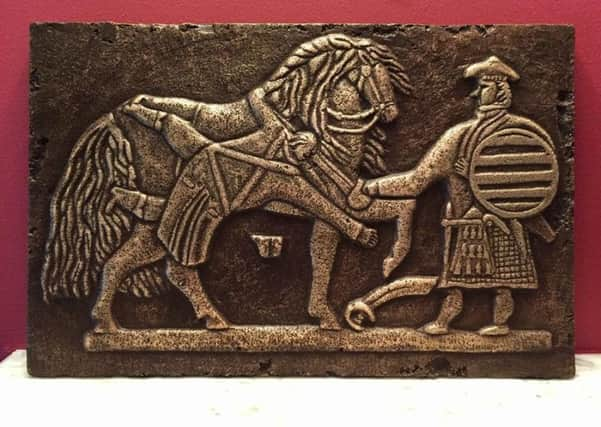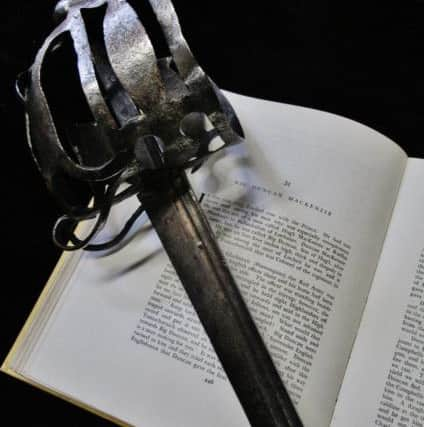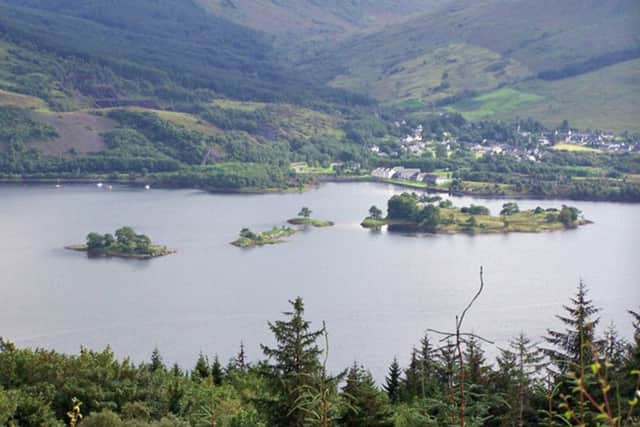Memorial for '˜supernatural' Jacobite fighter of 1745 rising


Donncha Mor Baile Caolais, or Big Duncan MacKenzie of Ballachulish, fought with Cameron of Lochiel in the Battle of Prestonpans in 1745.
He is remembered for slicing through the helmet of a British Government dragoon and cutting his head in two during the engagement.
Advertisement
Hide AdAdvertisement
Hide AdFollowing the brutal manoeuvre, MacKenzie is said to have picked up the two pieces of helmet before adding: “It may be that this will cause talk yet.”


The killing became celebrated by Jacobite supporters, with the death of the Redcoat depicted on the Jacobite’s gravestone on Eilean Munde, an island in Loch Leven near Ballachulish.
Now, the stone carving at MacKenzie’s island burial plot has been cast in bronze in order to create a memorial for the Highlander on dry land.
Created by stonemason David McGovern of Monikie, the memorial has gone on show at Aros na Fèinn cultural centre at North Ballachulish, with the sword used by MacKenzie at the Battle of Prestonpans now also found.
Advertisement
Hide AdAdvertisement
Hide AdPaul Macdonald, an armoury specialist and maker of custom swords, said: “Duncan MacKenzie was a man of the land and he was really just another man who signed up to fight, but he proved himself by performing this almost supernatural feat on the battlefield.”


The plaque was unveiled at the weekend by Griogair Labhruidh of Àros na Fèinn.
Details of MacKenzie’s battlefield actions were recorded in the late 19th century in the Dewar Manuscripts, a significant collection of Gaelic folklore commissioned by the 8th Duke of Argyll. Mr Macdonald added: “It is in the last few years that we have been able to pull everything together, from the story in the Dewar Manuscripts, to the sword and gravestone. The legend is now more complete.”
Mr Macdonald discovered Big Duncan’s sword in the collection held by the current Duke of Argyll at Inverary Castle. He was commissioned to refurbish and preserve the pieces in the Argyll armoury when he discovered the weapon.
Advertisement
Hide AdAdvertisement
Hide AdMr Macdonald said: “It was one of the last swords I came across in the collection. I couldn’t understand why it was so blunt. There is a blunt section that measures 10 to 11 inches.
“I’d never seen edge damage like it. To roll the edge like that must have taken some impact. The only thing that could cause that would be a massive amount of trauma. I knew this had to be Big Duncan’s sword.
“Cutting something hard enough, like an iron helmet and a head, would probably do it.”
The sword was later taken to Eilean Munde to rest on Mackenzie grave.
Advertisement
Hide AdAdvertisement
Hide AdThe MacKenzies were from Easter Ross and in the second half of the 16th Century assisted Cameron of Lochiel in a clan battle against the Mackintoshes. For their service, they were rewarded with lands around Ballachulish, Mr Macdonald said.
Big Duncan and his brother joined Lochiel’s regiment in 1745 and went on the campaign trail, making his name at Prestonpans. The battle, on 21 September 1745, was the first significant conflict of the rising.
The convincing Jacobite victory boosted the cause, leaving them in control of Scotland and opening the path south into England.
Afterwards, MacKenzie fled north with two friends but was captured after encountering British Government forces at Inveroran.
Advertisement
Hide AdAdvertisement
Hide AdAfter being sent to Kilchurn Castle at Loch Awe, the Jacobite went on trial but he was freed after a plea for clemency was sought by a Campbell, who had been sent to secure his release by his MacKenzie wife. The Jacobite was freed on condition he took up arms for the Stuart cause again, with his sword also surrendered.
It is understood that the MacKenzie sword is now due to be mounted in a display at Inverary Castle by the present Duke of Argyll.